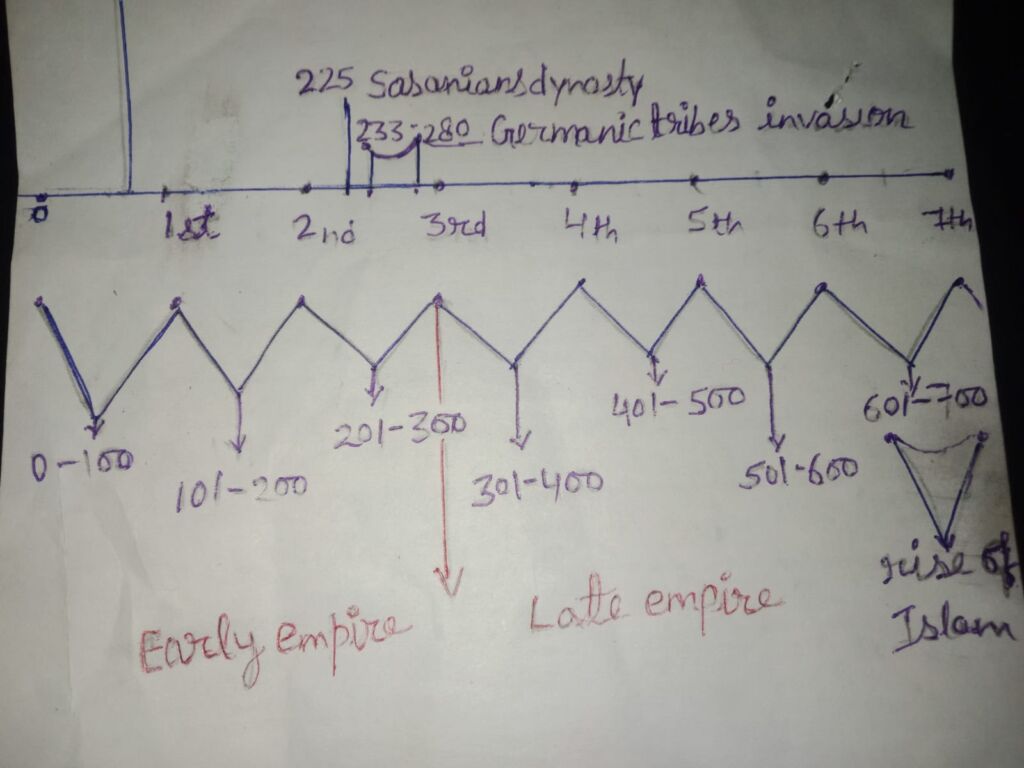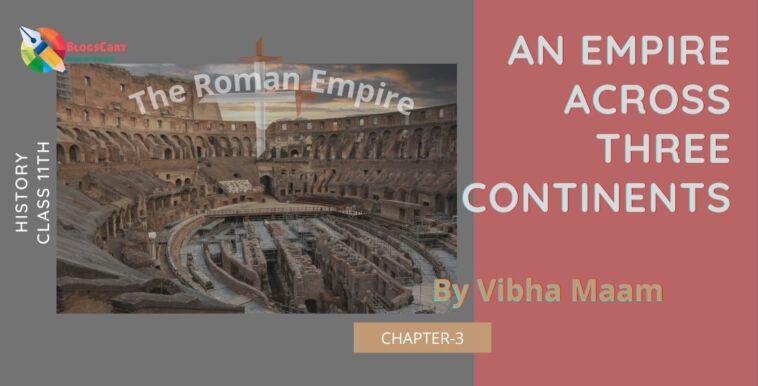Checkout handpicked notes of NCERT class 11th History Chapter 3 An Empire across three continents notes by Vibha Madam, and share it with your friends and classmates.
An Empire Across Three Continents Notes by Vibha Maam
The Roman Empire
The two powerful empires Rome and Iran ruled over most of Europe, North Africa and a large part of the fertile crescent (middle East) and the economy was done on slave labourers.
Women had a stronger legal position. There are three sources to understand the history of Roman empire
- Texts – Annals, letters, speeches, sermons, laws
- Documents – Inscriptions, papyrus( scholar called papyrologist)
- Material remains – Buildings, monuments, pottery, coins, mosaics, landscapes
Rome dominated the Mediterranean sea and all around regions in both directions North as well as south.
The Roman empire was bounded to the north by two great rivers, the Rhine and the Danube and to the South by the Sahara Desert.
The two empires are separated by the river Euphrates.
Rome towards the west and Iran towards the east of the Euphrates.
Europe and Africa are separated by the Mediterranean sea ( heart of Rome’s empire).
Iran controlled the Caspian sea in the South to eastern Arabian and sometimes large parts of Afghanistan.
The Roman Empire can broadly be divided into two phases: ‘early empire’ before the 3rd century and ‘late empire’ after the third century.

Difference between Roman and Persian Empire
- The Roman Empire was culturally more diverse than that of Iran.
- Many languages were spoken but administrative languages were only two: Greek and Latin.
- The Parthians and later the Sasanians, the dynasties, ruled Iran whereas the Roman empire was ruled by a system of government.
- Besides diversities in languages, all were subjects of a single ruler.
- The Romans had a paid and professional army and served at least 25 years but the Persian Empire had a conscripted (forced) army.
The Regime established by Augustus
- Augustus (Octavian) was the adopted son of Julius Caesar. he was the first emperor of the Roman empire in 27 BCE.
- Augustus established a regime called the ‘Principate’, by this he was a ‘leading citizen'( Princeps in Latin) not an absolute ruler.
- From 509 to 27 BCE, Rome was a Republic in which the real power of the Empire lay with the senate.
- The senate was a small group of wealthy families or nobility, who represented the Government of the Republic before 27 BCE.
- There were three players of the institution of imperial rule:-
a) The Emperor, b) the Senate & c) the Army.
- In the Roman empire, the army was the largest single organised body by the fourth century.
- It certainly had the power to determine the fate of emperors and the success of individual emperors depended on the control of the army.
- The soldiers would constantly agitate for better wages and service conditions.
- The senate hated and feared the army because it was a source of often unpredictable violence and caused civil war.
- The first two centuries were very calm, stable and free from civil war except year 69CE( a notorious year) because this year is known for quick succession when four emperors mounted the throne.
- Succession to the throne was based on family descent either natural or adoptive; for example Tiberius (14-37CE) was not the natural son of Augustus, who ruled the Roman empire after Augustus.
- The ‘Augustan age’ is remembered for its peace and vast empire. No expansion was required but Trajan’s occupation of territory (113-117CE) across the Euphrates was a failure
- Much more characteristic was the gradual extension of the Roman direct rule.
- A whole series of ‘dependent Kingdoms’ (near east) merged with the Roman empire but some of these Kingdom were very prosperous like Herod’s, yielding 5.4 million denarii per year.
- Denarii was a Roman silver coin containing about 4.5g pure silver.
- All the territories of the Empire were organised into provinces, except Italy and subject to taxation.
- By the 2nd century, the Roman Empire stretched from Scotland to the border of Armenia and from the Sahara to the Euphrates and sometimes beyond.
- The vast empire was controlled and administered through urbanization.
Urban Centers
- Carthage, Alexandria, Antioch were the great urban centers of the imperial system.
- The local upper classes of the city collaborated with the Roman state in administering and collecting taxes, supplying the army to them from their territory.
Roman Political History
- There was a dramatic shift in power between Italy and the provinces.
- A new elite group emerged and became more powerful than the senatorial class because they were supported by the Gallienus Empire.
- Italians continued to dominate the senate at least till the 3rd century.
- People in cities could survive in the condition of famines in the countryside.
- Important villages could be upgraded to the status of cities and cities degraded into village status.
- Public baths were used for religious baths in urban centers.
The Third Century Crisis
- In 225 CE, a more aggressive dynasty of Sasanians was expanding rapidly in the direction of the Euphrates.
- A whole period from 233 to 280 saw repeated invasions by Germanic tribes(Alamanni, the Franks and The Goths) and barbarians against the Rhine and Danube frontiers.
- The rapid succession of emperors (25 emperors in 47 years) were the major strains faced by the empire in the 3rd Century.
Gender, literacy, Culture
Gender
- The nuclear family prevailed in Roman society.
- Slaves were included in the family.
- The woman remained a primary heir of her father after her marriage and enjoyed complete legal independence.
- Males married in their late twenties and thirties whereas women were married off in the teen or early twenties. This age gap encouraged certain inequality.
- Divorce was relatively easy.
Literacy
The casual literacy rate varied greatly between different parts of the empire, for example for Pompeii had widespread casual literacy, advertisement and graffiti found all over the city, on other hand in Egypt (where papyrus is grown) most formal documents usually written by professional scribes.
Culture
The cultural diversity was reflected in many ways it could be shown in the vast diversity of religious cult and local deities, styles of dress and costume, food, social organisation, patterns of settlement, languages like
- Aramaic in the Near East
- Coptic in Egypt
- Punic and berber in N.Africa
- Celtic in Spain
- Coptic translation of the Bible by the mid- third century.
Economic Expansion
- The Empire had a substantial economic infrastructure of harbours, quarries, mines, brickyards, and olive oil factories.
- Wheat, wine and olive-oil were traded in huge amounts. They came from Spain, the Gallic, North-Africa, Egypt, and Italy.
- Liquids( wine, olive oil) were transported in containers (amphorae)
- By examining the clay pits, we know exactly where and what they carried.
- The Spanish olive-oil was carried in ‘dressel 20’ (containers).
- Spanish producers succeeded in capturing the olive oil markets from Italian enterprises. Spanish olive oil was better and cheaper than that of Italian olive oil. By the third and fourth century, North-African producers overtook the Spanish olive oil market
- After 425(fifth and sixth CE),North Africa dominance was broken by the east of the Mediterranean like Syria, Palestine became exporters of wine and olive oil because of excessive fertility.
- According to writers, like Strabo and Pliny, Compania was known for the best kind of wine, Sicily and Byzacium for export-quality wheat to Rome, Spain for olive oil, Galilee and Fayum were densely populated due to fertile soil.
Less Advanced State
- Transhumance (regular annual movement of pastoralists in search of pasture with their animals) was widespread in the country sides of Numidia along with oven shaped hut (Mapalia)
- Spain in the north was much less developed, inhabited in hilltop villages (Castella).
Technology
- In the ancient world, in the first and second centuries, they used diversified applications.
- They used water powered technology.
- They used hydraulic mining technology. the existence of a well organised commercial and banking network indicated its sophisticated features.
Controlling workers
- Slavery was an institution in the both in the Mediterranean and in the Near East.
- In the 4th CE, Christianity was the state religion but it didn’t belong to this institution.
- Slaves were an investment. in Italy, there were 3 million slaves out of 7.5 millions population.
- They were expensive. It might require food and health care by their master.
- The Roman upper classes were often cruel but ordinary people more compassionate and sympathy towards the slave compared than them.one incident occurred in the king Nero’s regime; when one slave murdered his master, ancient custom required that every slave of that house must be executed but crowd gathered and saved innocent slaves.
- In first century, the supply of slaves decline due to less warfare, the shortage of slaves could be accomplished by slave breeding and ways labourers.
- Wage labourers were cheap and dispensable.
- By providing free labour, slaves had been sent free by their masters. Slaves (freedman) were extensively used as business managers.
Management of Labour
- Columella (a first century writer) recommended that landowners should keep twice the requirement, supervision of workers, and groups of ten for easy production.
- Elder Pliny( author of Natural History) condemned the group of ten as the worst method because they were chained together by their feet.
- When agricultural, factories and workshops workers ran away to leave their masters or employers, a law of 398 passed.
- A law of 398 referred to workers being branded in the agreement of debt contracts.
- Rural indebtedness was even more widespread in a Jewish revolt of 66 struck and revolutionaries destroyed the moneylenders’ bonds.
- This is the best example of generosity of the Emperor Anastasius. In the late fifth century, they offered high wages to attract the laborers from all over the East to build the Eastern Frontier city of Dara. It was completed in less than three weeks.
Social Hierarchies
Tacitus described the leading social groups of the early Empire as follows:-
- Senators -Upper-class, privileged (partres, father)
- Equestrian – Knights, horsemen wealthy businessman
- The respectable section of the people
- Lower class – Plebs sordida, common man
- Slaves
Late Empire 4th century
- Senators and Equites -merged into Aristocracy (the origin from Africa)
- More wealthy but less powerful Middle class -connected with imperial services, bureaucracy and army
Lower class (Humiliores) – Labour and Workers
- In the early 5th century, the historian Olympiodorus described how the Aristocracy received their income in gold. The late Empire monetary system(silver based) broke because the Spanish silver mines were exhausted.
- Constantine founded the new monetary system on gold.
- The late Roman bureaucracy was a more excellent group because it drew the bulk of its salary in gold and invested much of this in buying up assets like land.
- There was a great deal of corruption especially in the judicial system and in administration of military supplies but the government repeatedly tried to curb it.
The Roman state was an authoritarian state.
- Dissent was not accepted and protest was responded with violence
- Emperors were not free to do whatever they liked
- They were restricted by the strong tradition of Roman law
Late Antiquity
4th to 7th century is the final period of revolution and breakup of the Roman empire. the 4th CE itself was one of considerable ferment both cultural and economic.
At the cultural level
- Constantine decided to make Christianity the official religion
- The rise of Islam in the 7th century
At an economic level
- the emperor Diocletian (284-305) had changed the structure of the state
- over expansion had led’ cut back’ by abandoning territories with less strategic or economic value
- fortified the frontiers reorganized provincial boundaries
- separated civilian from military functions
- granted greater autonomy to the military commanders (duces)
Constantine consolidated some of these changes and added others
- He introduced a new denomination monetary called solidus( a coin of 4.5 gram of pure gold)
- Created a second capital at Constantinople (modern Istanbul in Turkey) surrounded on three sides by the sea.
- As the new capital required a new expansion of governing classes
- Monetary stability and an expanding population stimulated economic growth
- Investment in industrial installations like oil presses, glass factories
- Revival of the large long-distance trade with the East
The traditional religious culture
Polytheism in both Greek and Roman involved in multiplicity of cults like Jupiter, Juno, Minerva and Mars Christianisation in 4th and 5th century
Falls of the Empire
In the East
Despite the impact of the plague ( 540 CE) the general prosperity and population was still expanding till the sixth century
In the West
- The Empire fragmented politically as Germanic groups from the North ( Goths, Vandals, Lombards) took over all the major provinces.
- By the early 7th century the war flared up again between Rome and Iran and Sasanians invaded all the major eastern provinces
- Byzantium ( the Roman empire) recovered their provinces in the 620.
- The expansion of Islam from its beginning in Arabia has been called the greatest political revolution ever to occur in the history of the ancient world.
- By 642,large parts of both the eastern Roman and Sasanian Empires had fallen to the Arabs in a series of stunning confrontations.
Don’t forget to comment in the comment section below to appreciate the hard work of our author by sharing this notes with your known person you can also Contact us for any query or if you are interested in writing with us.
Stay tuned for more amazing stories, poems & articles like this.











i believe Roman empire was the biggest empire in the history
It was British Empire
It was ottomam empire
The largest empire the world has ever seen was that established by the Mongols
Wow Mongols the greatest we should call ig
i like the notes. This is very helpful
Nice notes very helpful🙂🙂🙂🙂
Very helpful
Thank you 😊